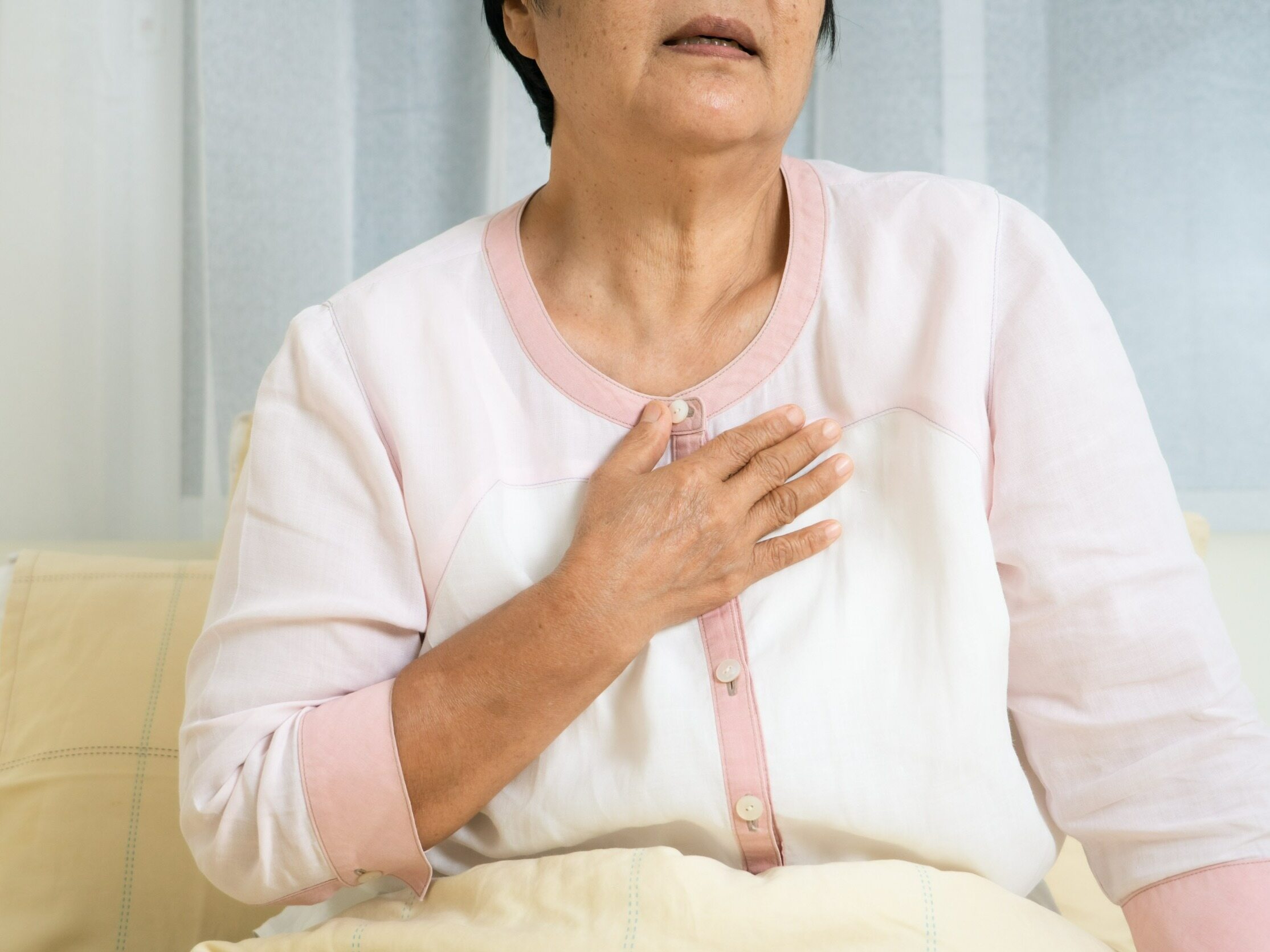Pain in the sternum – causes, accompanying symptoms, diagnosis and treatment

Pain in the sternum causes anxiety because it is most often associated with coronary pain that occurs during a heart attack. However, it is worth knowing that pain is also associated with other diseases. Most patients who experience pain in the sternum are not diagnosed with heart diseases, but with diseases of the digestive system. What are the most common causes of sternum pain? What symptoms of pain should prompt an immediate visit to a doctor? We explain.
- Sternum pain – possible causes
- Pain in the sternum and the disturbing symptoms that may accompany it
- Diagnostics of pain in the sternum
- Treatment of pain in the sternum
Myocardial infarction is not the only condition that causes pain in the sternum. Chest pain also occurs in the course of other heart diseases (e.g. angina, myocarditis, pericarditis) and may be associated with diseases that affect other organs of the chest and abdominal cavity. Not all diseases that cause chest pain require immediate medical attention, but pain, pressure or burning in the sternum area should always be consulted with a specialist.
Sternum pain – possible causes
Cardiovascular diseases are the acute and chronic diseases most often associated with chest pain. Both in the case of emergencies related to the heart (e.g. heart attack, myocarditis, pericarditis, cardiac arrhythmias) and in chronic diseases (e.g. coronary artery disease, heart failure, congenital and acquired heart defects) pain in the chest. Pain in the course of heart disease is localized around the sternum and may radiate, for example, to the abdomen, shoulder, jaw and back.
Pain in the upper part of the chest, although often mistaken for a heart attack, usually has a different cause. Pain in the sternum area is also caused by:
-
diseases of the digestive system (e.g. gastric ulcer, hiatal hernia, gallstones and other diseases of the biliary tract, gastroesophageal reflux disease, esophageal rupture, pancreatitis, gastritis),
-
respiratory system diseases (e.g. viral and bacterial bronchial infections, pneumonia, pleurisy, pneumothorax),
-
spine diseases (e.g. neuralgia caused by pressure or damage to nerve structures),
-
chronic stress,
-
neurotic disorders (formerly called cardiac neurosis),
-
lifestyle (e.g. slouching while working or studying),
-
chest injuries (e.g. sudden injury to the sternum joint, micro-injuries resulting in damage to the sternum and ribs, overload of the chest muscles),
-
posture defects (e.g. scoliosis).
There are many causes that can cause pain in the chest, around the sternum. There may be stabbing pain, stabbing pain, burning pain, and pressing pain in the chest area. Chest pain may worsen during activity and subside at rest, or may occur regardless of whether we are moving. Sometimes the pain is dull and only appears in certain situations.
In the course of serious diseases, it is rare for pain in the sternum to be the only symptom of the disease. Acute and chronic internal diseases usually cause other symptoms that worsen the patient’s overall well-being.
Pain in the sternum and the disturbing symptoms that may accompany it
Disturbing symptoms that should prompt an immediate visit to a doctor include:
-
sudden chest pain
-
general malaise,
-
palpitations,
-
profuse sweats,
-
weakness,
-
somnolence,
-
ground-like vomiting or hemoptysis,
-
paroxysmal cough,
-
coughing up pink, foamy or bloody secretions
-
dizziness,
-
shortness of breath,
-
disturbances of consciousness,
-
severe headache,
-
numbness, tingling or paresis of the upper limbs,
-
cyanosis.
The above alarm signals appear in the course of various diseases.
A heart attack often causes burning pain behind the breastbone, accompanied by anxiety, dizziness, palpitations, shortness of breath, and numbness or tingling in the left arm. However, you should know that characteristic symptoms do not always occur during a heart attack (e.g. in women).
Respiratory diseases (e.g. pneumonia or pleurisy) may cause shortness of breath, cough, expectoration of pink, foamy secretion, headache, dizziness and cyanosis.
However, in digestive system diseases, pain in the sternum is often accompanied by symptoms such as abdominal pain, nausea, vomiting and a burning sensation in the esophagus.
Stress and neurotic disorders cause chest tightness, heart palpitations, shortness of breath, weakness, anxiety, dizziness and other somatic symptoms typical of various diseases. Significant severity of symptoms indicates a panic attack – a person experiencing a panic attack for the first time has the impression that he or she is dying from a heart attack. A panic attack can lead to fainting due to hyperventilation. Typically, a panic attack lasts a few minutes and gradually subsides. A large percentage of patients who come to the emergency room with suspected coronary pain are people who experienced a panic attack.
Diagnostics of pain in the sternum
People experiencing pain should consult a doctor. Detecting the cause of pain in the sternum based on the nature and severity of the pain and their location is not a problem for an experienced doctor, but in order to confirm the initial diagnosis, it is necessary to perform various laboratory tests and imaging tests.
At the stage of diagnosing the cause of pain in the chest, around the sternum, the following procedures are performed:
-
peripheral blood count with smear,
-
general urine test,
-
chest x-ray (chest X-ray),
-
ECG examination (electrocardiography),
-
ECHO heart test (echocardiography),
-
Abdominal ultrasound.
Depending on the results of laboratory tests and imaging tests, further diagnostics are planned, which may include, among others: specialized cardiological tests. If the tests reveal, for example, markers of myocardial necrosis in the blood, both diagnosis and treatment are aimed at myocardial infarction.
Diagnosing the cause of pain in the sternum can take a long time. The test results do not always clearly indicate a specific disease, which means that the patient must seek advice from several specialists, e.g. a cardiologist, a gastroenterologist, an orthopedist, a pulmonologist, and even a psychologist or psychiatrist.
The occurrence of chest pain requires immediate treatment in the event of an emergency. Emergency conditions that pose a threat to health and life and require specialized treatment include not only myocardial infarction, but also, among others: acute heart failure and cardiac arrhythmias that may require cardioversion.
In the case of respiratory diseases, emergencies also occur, e.g. respiratory failure, pneumothorax, bronchial asthma attack, pneumonia and pleurisy, which pose a risk of cessation of breathing and hypoxia of body tissues.
Emergency situations in the course of digestive system diseases that may cause severe chest pain include: esophageal rupture, ulcer rupture, cysts and abscesses of internal organs, gallstone attack and acute pancreatitis.
Treatment of pain in the sternum
Treatment of sternum pain depends on its cause. It may be symptomatic or surgical treatment. The choice of treatment method depends on the stage of the disease and its course.
Sources:
-
Szczeklik A., Internal Medicine Szczeklik. Textbook of internal diseases, Medycyna Practical Publishing House, Kraków, 2013
-
Szczeklik A., Internal diseases, Volume I, Medycyna Practical Publishing House, Kraków, 2005
-
Szczeklik A., Internal diseases, Volume II, Medycyna Practical Publishing House, Kraków, 2006
-
Anna Doboszyńska, Symptoms of internal diseases. Handbook for students, Wydawnictwo Lekarskie PZWL, Warsaw, 2022






